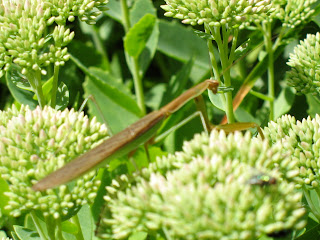What's the big deal with non-native plants? Many a New England yard is adorned with the "Asian Trio": Japanese Andromeda, Japanese Maple, and Forsythia. Why? They bloom early, are attractive and colorful, and hardy. I took some cuttings from the forsythia that came with my yard and set them up on the eroding incline between my garage and my neighbor's driveway four feet below. They established quickly, look pretty, and keep the soil from eroding along with the avalanche of acorns we get each year.
BUT...
Where invasive are concerned, they can ESCAPE. They can invade by seed, stem, or rhizome, in your tires, on your shoes, on your pets, carried by birds... Invasives can overgrow habitats, shade-out native species such as spring ephemerals, and out-compete natives, displacing the food source of many animals and insects. Sure, general feeder animals will eat the bittersweet choking the swamp maple or the autumn olives occupying the disturbed earth behind a certain schoolyard, but what of the creatures that are more selective? Monarch butterflies only eat milkweed, also laying their eggs there. With loss of habitat due to development and the introduction of invasive species crowding the milkweed out, the Monarch is having a tough time. Add to that the invasive Black Swallow Wort, which is in the same family as Milkweed and attracts the Monarch, but at a deadly price. It is poisonous to the caterpillars.
Swamp Milkweed from twofrogs.com
Black Swallow Wort from the Wisconsin Department of Natural Resources
The trio I mentioned are not invasive, but many non-native plants we put in our landscape are. No native plants, no native insects, no food chain that leads up to us. Animals cannot evolve fast enough to the rate of introduction. The climate warming just a few degrees could mean the kudzu problem of the south could be ours (not so many) years down the road.
What to do? Here are three great sites for more information: Invasive Species Noxious Weeds RI Invasive Species Alternatives. I have to admit, there is a butterfly bush in the school garden. But there is also native milkweed, bee balm, Joe Pye weed, and others that attract native species. I could replace the butterfly bush with a button bush or summer sweet, and still attract butterflies and hummingbirds. I did install the mason and bumble bee condos this morning, but that is a post for the future. I even started cutting down the honeysuckle this week, so my Liberty apple could make friends with my neighbor's crab apple. Another fruit that will require our insect friends, the bees...
Look around. Today, I got my second grade students to look. Last week, they made preying mantids from paper tubes and bendy straws, painting them with "camouflage". (You could make one too! Press tube flat to cut small slits to slide straws into. Our project is all tab and slot, not glue or tape.) We discussed how animals hide and why. In class, we examined a photocopied picture of a katydid and I had them draw it step-by-step, looking at the shapes, the sizes, the directions of its many parts. Then we went outside, where I gave them three minutes to hide their mantis, three minutes to find someone else's, and five minutes to discuss who's was the hardest to find and why. An unexpected surprise was finding a tiny unidentified golden insect with an upturned abdomen hiding inside one of the mantis sculptures. After consulting Bug Guide, I determined it was the nymph stage of a walking stick, although not identical to the one pictured in the link. Amazing! The student found it because he was LOOKING. Next week, they will draw real insects encased in lucite I secured with a grant from the Rhode Island Foundation, look this time with magnifying lenses.
Look around you. You want children to discover a walking stick in the schoolyard, a Monarch outside their window? Do you see the plants necessary for their habitat? Start making room, start planting.
Taken by me in Providence, in a 30 sq.ft. garden.




No comments:
Post a Comment